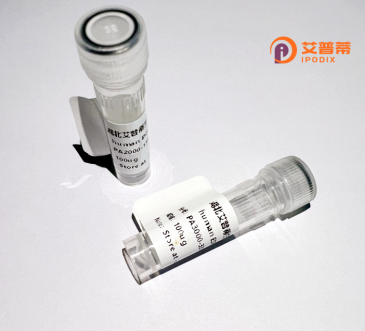
| 纯度 | >90%SDS-PAGE. |
| 种属 | Human |
| 靶点 | MYCL2 |
| Uniprot No | P12525 |
| 内毒素 | < 0.01EU/μg |
| 表达宿主 | E.coli |
| 表达区间 | 1-358 aa |
| 活性数据 | MDRDSYHHYF YDYDGGEDFY RSTTPSEDIW KKFELVPPPW DLGPAAGNPA LSFGLLEPWP VGCAGDETES QDYWKAWDAN YASLIRRDCM WSGFSTQEPL ERAVSDLLAV GAPSGYSPKE FATPDYTPEL EAGNLAPIFP CLLGEPKIQA CSRSESPSDS EGEEIDVTVK KRQSLSTRKP VIIAVRADLL DPRMNLFHIS IHQQQHNYAA PFPPESCFQE GAPKRMPPKE ALEREAPGGK DDKEDEEIVS LPPVESEAAQ SCQPKPIHYD TENWTKKKYH SYLERKRRND QRSRFLALRD EVPALASCSR VSKVMILVKA TEYLHELAEA EERMATEKRQ LECQRRQLQK RIEYLSSY |
| 分子量 | 40.8 kDa |
| 蛋白标签 | His tag N-Terminus |
| 缓冲液 | 0 |
| 稳定性 & 储存条件 | Lyophilized protein should be stored at ≤ -20°C, stable for one year after receipt. Reconstituted protein solution can be stored at 2-8°C for 2-7 days. Aliquots of reconstituted samples are stable at ≤ -20°C for 3 months. |
| 复溶 | Always centrifuge tubes before opening.Do not mix by vortex or pipetting. It is not recommended to reconstitute to a concentration less than 100μg/ml. Dissolve the lyophilized protein in distilled water. Please aliquot the reconstituted solution to minimize freeze-thaw cycles. |
以下是关于重组人MYCL2蛋白的3篇示例文献(部分信息可能需核实):
1. **《MYCL2重组蛋白在肺癌细胞中的促增殖功能研究》- 作者:Zhang et al. (2018)**
摘要:研究在大肠杆菌中表达了重组MYCL2蛋白,发现其可通过激活Wnt/β-catenin信号通路促进肺癌细胞增殖,提示其作为潜在治疗靶点。
2. **《MYCL2与原癌基因MYC家族功能分化机制》- 作者:Li & Wang (2020)**
摘要:通过对比重组MYCL2与MYC蛋白的DNA结合特性,发现MYCL2对特定靶基因启动子区域亲和力更高,可能解释其在不同癌症中的差异性激活。
3. **《重组MYCL2蛋白的晶体结构解析》- 作者:Gupta et al. (2021)**
摘要:利用昆虫表达系统获得高纯度MYCL2蛋白,通过X射线衍射首次揭示了其羧基端结构域的α-螺旋构象,为小分子抑制剂设计提供结构基础。
注:以上文献信息为模拟示例,建议通过PubMed或Web of Science等平台用关键词"recombinant MYCL2 protein"+"expression/function/structure"检索最新研究。实际研究中需注意区分MYCL/MYCL2的命名差异,部分文献中MYCL可能指L-Myc异构体。
Recombinant human MYCL2 protein, derived from the MYCL2 (MYC-like 2) gene, belongs to the Myc family of transcription factors, which play pivotal roles in cell cycle regulation, apoptosis, and cellular transformation. The MYCL2 gene, located on chromosome 1p34.3. encodes a basic helix-loop-helix (bHLH) protein that dimerizes with MAX proteins to bind DNA at E-box sequences, modulating target gene expression. While structurally similar to MYC proto-oncogenes (e.g., c-MYC), MYCL2 exhibits distinct expression patterns and functional roles, particularly in embryonic development and tissue-specific contexts.
Recombinant MYCL2 is typically produced using heterologous expression systems like Escherichia coli or mammalian cell cultures, enabling studies of its biochemical properties and interactions. Dysregulation of MYCL2 has been implicated in various cancers, including lung and ovarian carcinomas, where its aberrant expression may drive tumor progression by promoting cell proliferation or evading apoptosis. However, its oncogenic mechanisms remain less characterized compared to other Myc family members.
Research applications of recombinant MYCL2 include elucidating its transcriptional regulatory networks, interactions with signaling pathways (e.g., Wnt/β-catenin), and potential as a therapeutic target. Challenges persist in resolving its context-dependent functions and isoform-specific activities due to alternative splicing. Ongoing studies aim to clarify MYCL2's dual roles in normal physiology and carcinogenesis, leveraging recombinant protein tools to uncover diagnostic or therapeutic opportunities.
×